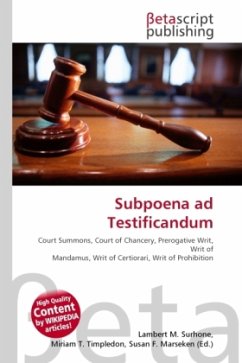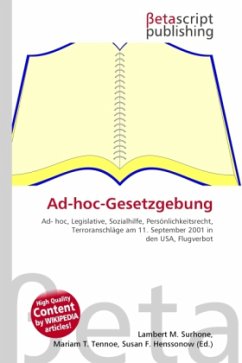
Subpoena ad Testificandum
Versandkostenfrei!
Versandfertig in 6-10 Tagen
26,99 €
inkl. MwSt.

PAYBACK Punkte
13 °P sammeln!
High Quality Content by WIKIPEDIA articles! A subpoena ad testificandum is a court summons to appear and give oral testimony for use at a hearing or trial. The subpoena developed as a creative writ, the "writ subpoena", from the Court of Chancery. Writs of many kinds formed the essential parts of litigation. The primary function of a writ in the 13th and 14th centuries was to convey the king's commands to his officers and servants. It was irrelevant what the nature of those commands might be. The Register of Writs shows a large variety of writs to be administrative in nature, as opposed to jud...
High Quality Content by WIKIPEDIA articles! A subpoena ad testificandum is a court summons to appear and give oral testimony for use at a hearing or trial. The subpoena developed as a creative writ, the "writ subpoena", from the Court of Chancery. Writs of many kinds formed the essential parts of litigation. The primary function of a writ in the 13th and 14th centuries was to convey the king's commands to his officers and servants. It was irrelevant what the nature of those commands might be. The Register of Writs shows a large variety of writs to be administrative in nature, as opposed to judicial. These former writs acquired the name prerogative writs in the 17th and 18th centuries. Prerogative writs that have survived into modern law are the writ of mandamus and writ of certiorari. The medieval writ of prohibition played an important part in the conflict between the church and state in England. The writ was also used in the courts of admiralty and local courts. It has survivedin relative obscurity in United States law. The writ subpoena began to be attached to a wide variety of writs in the 1300s.












